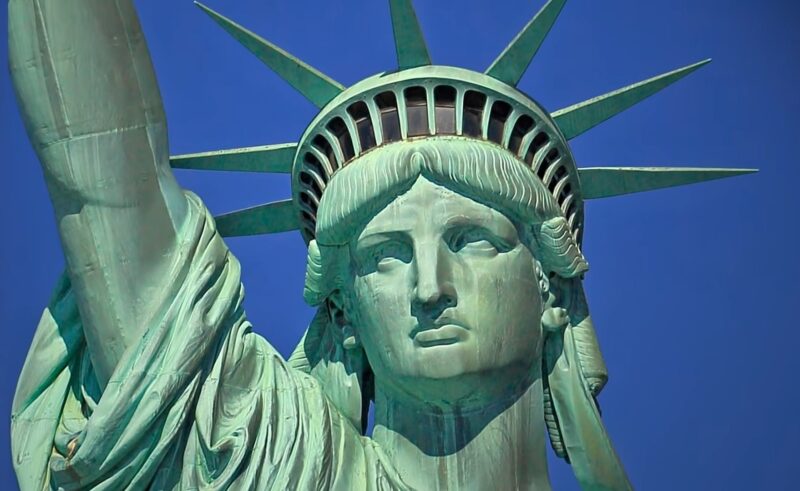The Statue of Liberty, or “Liberty Enlightening the World” as it’s officially named, stands as a colossal neoclassical sculpture on Liberty Island in New York Harbor. This iconic figure, a gift from the people of France, was designed by the French sculptor Frédéric Auguste Bartholdi, with its metal framework constructed by Gustave Eiffel. Dedicated on October 28, 1886, this copper statue represents Libertas, the Roman Goddess of Liberty, and has since become a symbol of freedom and the United States.
But Im sure you have stopped to think about the weight of this massive monument. I know I have. And that’s what you’re here to learn today.
Weight of the Statue’s Components

The Statue of Liberty is an intricate masterpiece, made up of various components, each with its own significance and weight. Let’s break it down:
- Crown: The crown, adorned with seven spikes representing the seven continents, is a symbol of liberty shining worldwide. Each spike is 9 feet long and weighs around 150 pounds.
- Face: Lady Liberty’s face, an emblem of freedom, is 8 feet tall. Her eyes are about 2 feet wide, her nose is 4 feet 6 inches long, and her mouth spans 3 feet.
- Torch: The torch, symbolizing enlightenment, is one of the statue’s most iconic features. The flame alone is 29 feet 6 inches tall, made of copper sheets covered in gold leaf.
- Tablet: Held in her left hand, the tablet measures 23 feet 7 inches tall and 13 feet 7 inches wide. It’s inscribed with the date of the U.S. Declaration of Independence in Roman numerals.
- Copper Skin: The statue’s skin, made of copper, is only 3/32 of an inch thick, roughly the thickness of two pennies stacked together. This thin layer allows the statue to sway slightly in the wind, ensuring its durability.
The primary material used in the statue’s composition is copper, which plays a pivotal role in its iconic greenish-blue patina. Over time, the copper reacts with the elements, forming a layer of verdigris that protects the statue from further corrosion.
Total Weight of the Statue

Lady Liberty is not just tall; she’s heavy too. Without the pedestal, the statue weighs approximately 225 tons.
The copper skin alone weighs about 31 tons, while the steel framework, designed by Alexandre Gustave Eiffel, weighs nearly 125 tons. The pedestal and foundation add a whopping 54,000 tons to the total weight of the monument. This immense weight posed challenges during its transportation from France and its assembly on Liberty Island.
| Component | Weight |
| Copper Skin | 31 tons |
| Steel Framework | 125 tons |
| Total Statue (without pedestal) | 225 tons |
| Pedestal and Foundation | 54,000 tons |
Maintenance and Preservation
Maintaining the Statue of Liberty is no small feat, especially considering its weight and exposure to the elements. The statue’s weight plays a crucial role in its stability, but it also poses challenges for maintenance crews. For instance, any restoration work requires equipment that can handle the statue’s massive size.
Over the years, efforts have been made to prevent corrosion and decay. The statue’s thin copper skin, while durable, is susceptible to the elements. To protect it, various treatments have been applied to prevent corrosion and maintain its iconic appearance.
In recent times, there have been significant restoration projects to ensure Lady Liberty stands tall for generations to come. These projects not only focus on the statue itself but also on its pedestal and the infrastructure supporting it.
Compared to Other Monuments

When we think about the Statue of Liberty, its grandeur and symbolism often overshadow its physical weight. But how does it compare to other iconic landmarks around the world? Let’s take a look:
- Eiffel Tower: Located in Paris, this iron lattice tower weighs about 10,100 tons. It’s interesting to note that Gustave Eiffel, who played a role in the Statue of Liberty’s framework, is the man behind this iconic tower.
- Big Ben: The bell inside the clock tower, commonly referred to as Big Ben, weighs 13.7 tons. The tower itself, now known as the Elizabeth Tower, has a much greater weight.
- Great Pyramid of Giza: This ancient wonder, built as a tomb for Pharaoh Khufu, has an estimated weight of 5.9 million tons.
In this context, the Statue of Liberty, weighing in at 225 tons (without its pedestal), might seem lightweight. But its significance and symbolism carry a weight that’s immeasurable.
Fun Facts and Trivia
- Wind Sway: Did you know that in 50 mph winds, the Statue can sway up to 3 inches, and the torch can move up to 6 inches? That’s some impressive engineering!
- Direction: Lady Liberty faces southeast, perfectly aligning with Fort Wood’s placement and offering a welcoming sight for those entering the harbor.
- The Torch: The current torch is a replacement of the original and was installed in 1986. It’s made of copper and covered in 24k gold leaf. During the day, sunlight reflects off the gold, and at night, floodlights illuminate the torch.
FAQ
Why is the Statue of Liberty green?
The green hue of the Statue of Liberty is due to the natural oxidation of its copper skin. This process forms a layer of verdigris, which gives the statue its familiar “patina” green coating. This patina is as thick, in many places, as the copper behind it and acts as a protective layer, preventing the copper from wearing away further.
Has the torch always been the same since the statue’s inception?
No, the current torch of the Statue of Liberty is a replacement of the original. The original torch was removed in 1984. The current torch, added in 1986, is made of copper and covered in 24K gold leaf. It reflects the sun’s rays during the day and is illuminated by 16 floodlights at night.
What’s the significance of the seven spikes on the Statue’s crown?

The seven spikes on the Statue of Liberty’s crown represent a radiant halo, also known as an “aureole.” These rays symbolize the spreading of freedom and enlightenment to the seven continents of the world.
Conclusion
The Statue of Liberty, with its towering presence in New York Harbor, is not just a symbol of freedom and hope but also an engineering marvel. Its weight, both in terms of physical mass and historical significance, is immense.
As we’ve explored its components, compared it to other landmarks, and delved into fun facts, it’s clear that Lady Liberty’s enduring significance is as weighty as the statue itself.
Whether you’re marveling at its design, reflecting on its history, or simply appreciating its presence, the Statue of Liberty stands as a testament to the ideals it represents.
